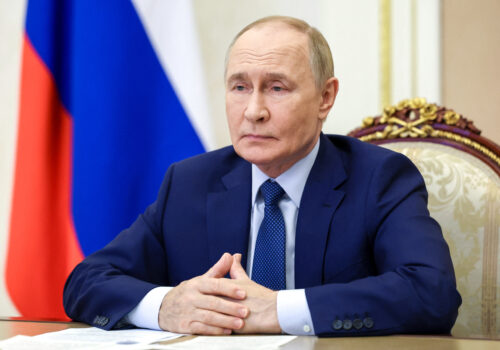The invasion unleashed by Vladimir Putin almost four years ago has often been called unprovoked, but nobody can say it was entirely unexpected. On the contrary, the full-scale invasion of 2022 was merely the latest and most extreme stage in a prolonged campaign of escalating Russian aggression aimed at preventing Ukraine from leaving the Kremlin orbit and resuming its place among the European community of nations.
During the early years of Putin’s reign, this campaign had focused primarily on massive interference in Ukrainian domestic affairs. Following Ukraine’s 2014 Revolution of Dignity, the Russian dictator opted for a far more forceful combination of military and political intervention. When even this descent into open aggression failed to derail Kyiv’s westward trajectory, Putin sought to solve Russia’s Ukraine problem once and for all by launching the largest European invasion since World War II.
As the fifth year of the war looms on the horizon, there is very little to indicate that Putin’s hard line tactics are working. While Russia has managed to occupy around 20 percent of Ukraine, opinion in the remaining 80 percent of the country is now overwhelmingly hostile to Moscow and supportive of closer European ties. For the vast majority of people in Ukraine, the invasions of 2014 and 2022 represent watershed moments that have profoundly impacted their understanding of Ukrainian identity while radically reshaping attitudes toward Russia.
The transformation in Ukraine’s geopolitical orientation is being mirrored by changes taking place domestically as the country’s center of gravity shifts decisively from east to west. For the first decade or so of independence, Ukraine was politically and economically dominated by the industrial east, with major cities including Donetsk, Kharkiv, Dnipro, and Zaporizhzhia serving as power bases for billionaire oligarch clans who shaped the Ukrainian national narrative and helped maintain high levels of Russian influence across the country. At the time, the comparatively quaint cities of central and western Ukraine lacked the wealth and general wherewithal to compete.
The first indication of a significant change in this dynamic was the 2004 Orange Revolution, which saw an unprecedented nationwide protest movement erupt over an attempt to falsify the country’s presidential election orchestrated by Kremlin-backed political forces rooted firmly in eastern Ukraine. This popular uprising represented a clear and unambiguous rejection of the idea that Ukraine was inextricably bound to Russia. A decade later, the onset of Russian military aggression would turbo-charge modern Ukraine’s historic turn toward the west.
Stay updated
As the world watches the Russian invasion of Ukraine unfold, UkraineAlert delivers the best Atlantic Council expert insight and analysis on Ukraine twice a week directly to your inbox.
Since 2014, traditional east Ukrainian bastions of Russian influence such as Donetsk and Luhansk have been occupied by Kremlin forces and effectively cut off from the rest of Ukraine. More recently, the full-scale invasion has left the broader Donbas region devastated and depopulated, while the formerly preeminent metropolises of the east face an uncertain future as fortified front line cities under relentless Russian bombardment.
The situation in western Ukraine is strikingly different. Cities throughout the region are experiencing rapid growth thanks to an influx of families and businesses seeking to relocate away from the war zone. The experience of Lviv since 2022 illustrates this trend. The largest city in western Ukraine, Lviv’s population has expanded by around a quarter since the start of Russia’s full-scale invasion to reach approximately one million. The Lviv real estate market has comfortably surpassed the regional capitals of eastern Ukraine and now rivals Kyiv itself. Likewise, Lviv is also second only to the Ukrainian capital in terms of new companies and investments.
Politically and diplomatically, Lviv is clearly in the ascendancy. Many Kyiv embassies partially relocated to the city in 2022 and continue to maintain a presence. Over the past three years, Lviv has hosted a number of high-level international events including presidential summits and gatherings of EU ministers. The rise of Lviv has been so striking that it has sparked rumors of jealousy among the establishment in Kyiv, with some suggesting that the potential reopening of Lviv International Airport has been deliberately sidelined in order to prevent the further eclipse of the Ukrainian capital.
Eurasia Center events

Whatever happens in the war, the shift in Ukraine’s national center of gravity toward the west of the country is unlikely to be reversed. In addition to the urgent impetus provided by Russia’s ongoing invasion, the emergence of western Ukraine is also being driven by the pull factor of EU integration. Over the past decade, Ukraine has secured visa-free EU travel and been granted official EU candidate status. This is transforming the investment climate in western Ukraine, which shares borders with four EU member states.
Large-scale infrastructure projects are already helping to cement western Ukraine’s status as the country’s most attractive region and gateway to the EU. Work on a 22km European-gauge railway line from the EU border to Uzhhorod was completed earlier this year, while construction of a far more ambitious Euro-gauge line connecting Lviv to the Polish border is scheduled to begin in 2026. As the EU accession process continues to gain momentum, these logistical links will only strengthen.
It remains unclear exactly when Ukraine will become a fully fledged EU member state, but there is a growing sense of confidence throughout the country that the once distant dream of EU membership is now finally within reach. For western Ukraine in particular, joining the European Union will complete the region’s historic journey from imperial outpost on the fringes of the Soviet Empire to economic engine nestled in the heart of the world’s largest single market.
All this is very bad news for Vladimir Putin. The Kremlin dictator’s Ukraine obsession reflects his fear that the consolidation of a democratic, European, and genuinely independent Ukraine could serve as a catalyst for the next phase in the long Russian retreat from empire that began almost four decades ago with the fall of the Berlin Wall. As Putin’s reign has progressed, his determination to prevent Ukraine’s geopolitical defection has only intensified, as has his readiness to sacrifice Russia’s more immediate national interests in pursuit of his anti-Ukrainian crusade. It is now increasingly obvious that his decision to invade Ukraine has backfired spectacularly, eroding centuries of Russian influence while accelerating the European integration he so bitterly opposes.
Unless Putin succeeds in dismantling Ukrainian statehood entirely and erasing the very idea of the Ukrainian nation, he must surely realize that the Ukraine of the postwar period is now destined to establish itself within the wider Western world while remaining implacably hostile to Russia. Rather than acknowledging this disastrous outcome, he will seek to continue the war indefinitely. If he stops now and accepts a compromise peace, Putin knows he will be doomed to enter Russian history as the man who lost Ukraine.
Peter Dickinson is editor of the Atlantic Council’s UkraineAlert service.
Further reading
The views expressed in UkraineAlert are solely those of the authors and do not necessarily reflect the views of the Atlantic Council, its staff, or its supporters.

The Eurasia Center’s mission is to enhance transatlantic cooperation in promoting stability, democratic values, and prosperity in Eurasia, from Eastern Europe and Turkey in the West to the Caucasus, Russia, and Central Asia in the East.
Follow us on social media
and support our work
Image: Russian dictator Vladimir Putin attends a meeting with head of Crimea Sergei Aksyonov in Moscow, Russia. November 11, 2025. Sputnik/Gavriil Grigorov/Pool via REUTERS





